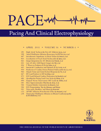An Algorithm to Predict the Site of Origin of Focal Atrial Tachycardia
Zhi-Yong Qian is now working in Taixing People's Hospital, Jiangsu Province, China.
Abstract
Background: Only a few algorithms for predicting the site of origin of focal atrial tachycardia (AT) have been reported. We aimed to develop a new and more effective algorithm.
Methods: Surface 12-lead electrocardiograms were collected during tachycardia and sinus rhythm in 61 patients who received successful radiofrequency ablation. P-wave polarities, durations, and amplitudes were analyzed. Predictive values of the most significant parameters were determined. An algorithm was then developed and prospectively evaluated in 30 new consecutive AT patients.
Results: Thirty-six percent (22/61) of the foci were located at the ostium of coronary sinus (CS). Other common foci included pulmonary veins (PVs, n = 15), right atrial appendage (RAA, n = 7), parahisian area (n = 7), and crista terminalis (CT, n = 3). Positive P waves in inferior leads (II, III, and aVF) and a negative P wave in lead aVR indicated high atrial origins (high CT, superior PVs, and RAA, defined as Area A), with a sensitivity of 95% and a specificity of 90%. Negative P waves in inferior leads and a positive P wave in lead aVR suggested right low septal origins (CS ostium and inferior tricuspid annulus, defined as Area B), with good sensitivity and specificity (88% and 89%, respectively). This new P-wave diagnostic algorithm correctly identified the site of origin in 90% of AT cases.
Conclusion: Combination of data from multiple leads and regrouping of sites of origin provides a better predictive value. (PACE 2011; 34:414–421)




